Vendhaya Kuzhambu (Fenugreek-Tamarind Stew) by DK on Feb 20, 2012
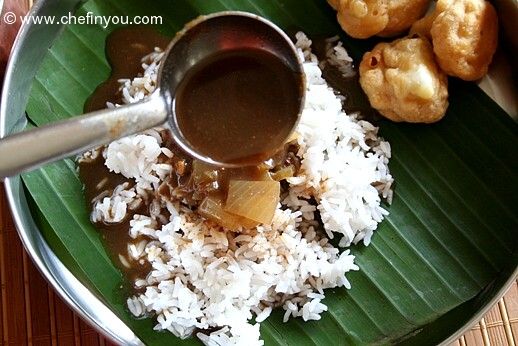
Tangy stews referred to as Kuzhambu or kulambu were my favorites after Sambar. I never was a Rasam person. Not in the sense of hating it, but in the sense of not being goo goo eyed at it. The way I do for these. My mom is an exceptional cook (the best - like every kid out there thinks of his/her mom!). She can cook a different meal - 3 times a day - with no repetition for a whole month. That's how good she is. I am so in love with her kuzhambu recipes. Somehow, it never tastes like hers when I make it. Yes, it could be possibly due to the fact I am dumb when I have to follow instructions verbatim, but still.

Kuzhambu is a tamarind stew made with a tempering of assorted dals and spices with or without vegetables. I believe that there are as many varieties of Kuzhambu as there are South Indians. Yes, though it sounds exaggerated, I tend to believe it, having come across so many types in my life till date - each one, unique and immensely flavorful.
- Cook time:
- Prep time:
- Serves: 2 people
Ingredients
- For the Base
- 1 cup (abt 120 gms) Onion, coarsely chopped, optional - (see Tips)
- Large pinch Asafoetida
- 2 tsp Tamarind Paste - (see Tips)
- 1 tbsp Sambar powder - (see Tips)
- 2 cups water
- Salt to taste
- few Curry leaves to garnish
- For Tempering
- 1-2 tsp Sesame oil
- 1/4 tsp Mustard seeds
- 1/2 tsp Fenugreek seeds
- 1 tsp Pigeon peas (Toor Dal)
- 1/2 tsp Black gram (split and skinned)
- 1 dried Red Chilli, broken (optional)
Tips
1. Onion - My mother never added Onion to this, but I do it normally since my family likes this version better. You can skip it completely or you can also use Shallots/Pearl onions for this.
2. Tamarind Paste - The amount will vary depending on the brand you use and the taste. I use a Tamicon brand and for us 2 tsp of this works fine. You can go the traditional route and use regular tamarind (a lime sized ball should suffice), drop it in hot water (2 cups worth) and extract all the juice. Discard the tamarind and use this water instead of regular water in this recipe.
3. Sambar Powder - Like any dutiful daughter, I tend to follow my mom's recipe for Sambar powder. So for us with this powder, 1 tbsp works great. But if you have your own recipe for the powder or are using store bought powder, you will have to adjust the amount. Start with 1/2 tbsp and work around your requirements.
4. Some version of Kuzhambu include using Bengal Gram (channa dal) as one of the tempering ingredients. I normally do not but you can additionally use 1 tsp of channa dal to this recipe if you wish.
2. Tamarind Paste - The amount will vary depending on the brand you use and the taste. I use a Tamicon brand and for us 2 tsp of this works fine. You can go the traditional route and use regular tamarind (a lime sized ball should suffice), drop it in hot water (2 cups worth) and extract all the juice. Discard the tamarind and use this water instead of regular water in this recipe.
3. Sambar Powder - Like any dutiful daughter, I tend to follow my mom's recipe for Sambar powder. So for us with this powder, 1 tbsp works great. But if you have your own recipe for the powder or are using store bought powder, you will have to adjust the amount. Start with 1/2 tbsp and work around your requirements.
4. Some version of Kuzhambu include using Bengal Gram (channa dal) as one of the tempering ingredients. I normally do not but you can additionally use 1 tsp of channa dal to this recipe if you wish.
Method
1.
In a deep saucepan, add the sesame oil. When hot, add the mustard seeds. When it starts popping, add the remaining dals and fenugreek to it. Keep the heat low-medium. You do not want to burn the dals - esp. fenugreek which turns bitter when even slightly burnt.
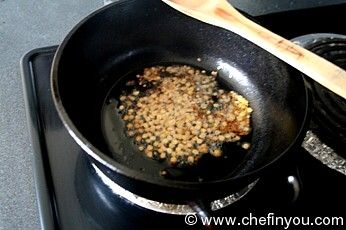
2.
When the dal gets reddish brown, add the onions.
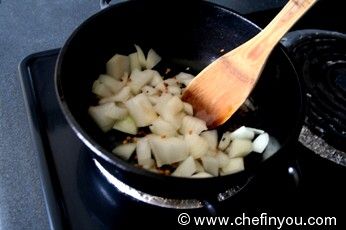
3.
Add salt and asafoetida and give it a stir. At this point, as the onion is getting soft (around 3-4 min mark), the aroma that wafts from this mixture is so typical of a South Indian household :).
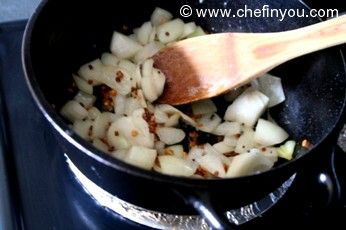
4.
Add the water
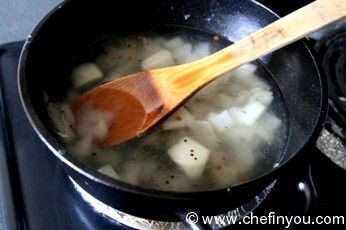
5.
along with curry leaves. You can also add them along with onions instead of now (or do 50-50). Increase the heat to med-high.
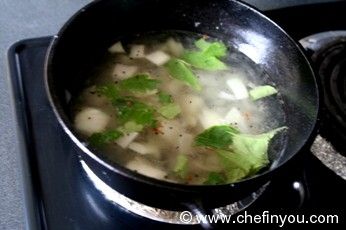
6.
When the water starts boiling, add the tamarind paste.
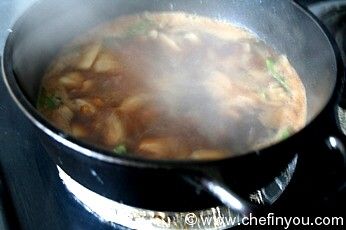
7.
In around 2 minutes, add the sambar powder. Stir until combined and continue cooking until the raw smell of Tamarind is replaced with a tangy aroma.
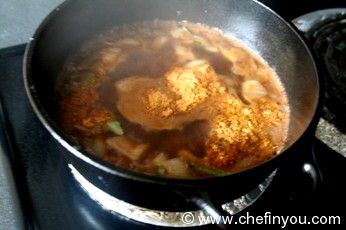
8.
You can at this point continue cooking (simmering) for another 6-7 minutes until the mixture thickens or (after reducing heat to low-med) mix 1 tsp of rice flour along with 1 tbsp cold water into a paste and add it to the stew. This will thicken it in less than 1-2 minutes.
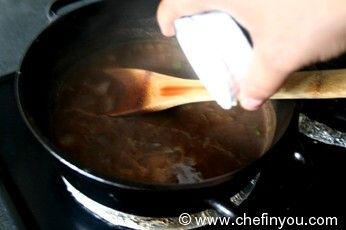
Serve this with steamed rice. A little goes a long way and you do not need to dollop generous amount like how you would do for a sambar or rasam. I usually love this with roasted potatoes or Taro root (seppakizhangu fry), but on this day we had it with Beans Poriyal and cauliflower Bhajji (pakora).
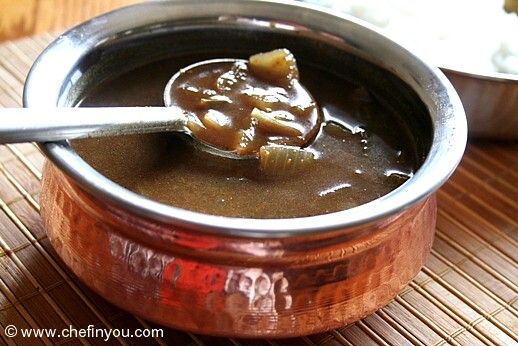

Filed Under these categories
- 291 Dairy Free
- 39 Easy Rice Recipes
- 447 Gluten Free
- 384 Nuts Free
- 9 Stews
- 5 Stews
- 73 Under 15 minutes - Main Course
- 499 Vegan Recipes
Ideal Accompaniments
Homemade Tamarind Paste (OPOS®) By DK on Nov 8, 2017
Related Articles
Recipe Reference
this is my mom's recipe which i have adapted minimally to add onions.
Related Posts
5 min (OPOS ) Milagu Kuzhambu (Pepper Tamarind Stew) By DK on Feb 20, 2017
Homemade Tamarind Paste (OPOS®) By DK on Nov 8, 2017
South Indian Sambar By DK on Aug 8, 2012
South Indian Tamarind Rice By DK on Jan 8, 2010
6 min Mor Kulambu (OPOS©) By DK on Sep 4, 2018
Kajur Imli Ki Chatni / Date Tamarind Chutney (Chaat) By DK on May 15, 2018
Leave a Reply
I love to hear from you! I read each and every comment, and will get
back as soon as I am able to.
1 Member Reviews
By mrudu on Feb 27, 2012
Hi Divya,
I tweaked your recipe my way slightly. for one, i dint add any hing or asafoetida since i dint have any. Then I also added some veggies so as to have a crunch. Turned out delightfully. Great recipe...thanks.
9 Comments
By PJ on Feb 25, 2012
Hi Divi,I am a rasam person.Can't dream of a meal without it. I do like samabar/kootu etc and this is one of my favorites.Reminds me to ask mom to make it for me.
Btw,I sent you a mail a couple of days back,hope you got it...
OMGGGGGG!!! Saw it just now .....!
By Ranganathan on Feb 23, 2012
I made this. This is the first time I am posting here. I tried a minor variation of the recipe. I added not only Tur daal but also some Urad daal (here I get it full but without the skin) and chana daal (also full). Not only onions, I added capsicum. I followed the instructions in the recipe. It turned out very well. The next time I make it, I intend to add carrots, peas. Thanks for the great recipe.
By Chitra on Feb 22, 2012
When you fry the sambhar powder, add the rice powder also instead of adding it at the end. This gives a better texture to both vendhaya kuzhambu & vetha kuzhambu :) :)
By Rama on Feb 21, 2012
Very nice DK. Excellent recipe. Very traditional and homely. In the US we have fewer options of vegetables to go with this Kuzhambu. I did however try Daikon (white mullangi) and manthakalikai. The taste was excellent. Do try this idea and let me know. I also agree with Swedhana... spice powders always taste better when you add them to oil than directly into the gravy. One more tip... if you run out of sambhar powder... paprika is an awesome option (slightly spicy though). Great work.. keep 'em coming. :)
By Purnima on Feb 21, 2012
I have always been a huge fan of your blog...love the recipes, especially the authentic South Indian ones :) But I've to mention I am totally in smitten of the way you present the tips.I just adore your 2 bits connecting it to your mom,childhood or present family.Thanks & yes,keep the recipes coming...straight from your kitchen :-D
Aweeee...thank you so much for the sweetest comment Purnima :) --DK
By Rathai on Feb 21, 2012
My mother also makes vendhaya kuzhambu but I never cared much for it. That may be because I'm still living with my parents. I guess it's a classic case of, you don't appreciate what you have while you still have it sometimes and only learn to appreciate these things you took for granted, when you can't have them anymore. I loved the traditional presentation and the kuzhambu looks very flavourful and inviting.
By Poornima on Feb 20, 2012
That looks yumm! Love these kind of curries too! I miss my mom now for all the varieties she makes :)
By Swedhana on Feb 20, 2012
Hi DK,
The kuzhambu just looks too good.. If I may, just a small suggestion on the kuzhambu taken from my paati's cooking notes. Add the Sambar powder as you fry the spices and then add onion and tamarind paste. This will give you even a better flavor. Also if you add tomato puree with the tamarind water, the addition of rice flour can be avoided and yet a wonderful consistency will be achieved. Do try this version and check out if this suits your taste buds.
Thats an awesome suggestion. Will def. try it. Thanks Swedhana :)


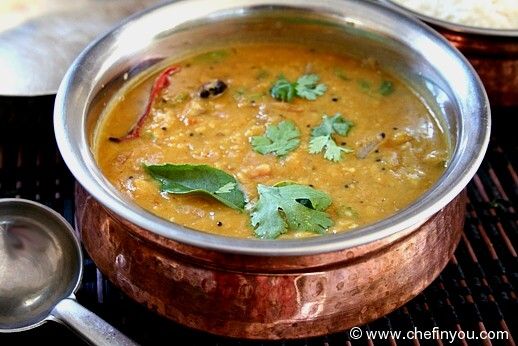
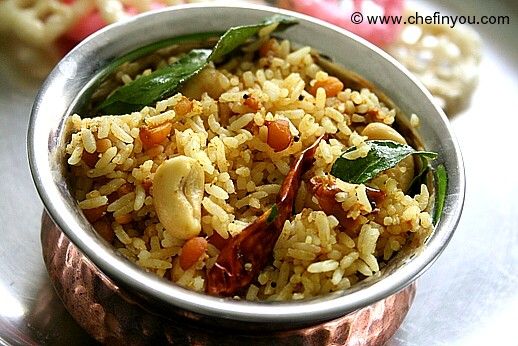


By Jimmy the Kid on Jan 4, 2015